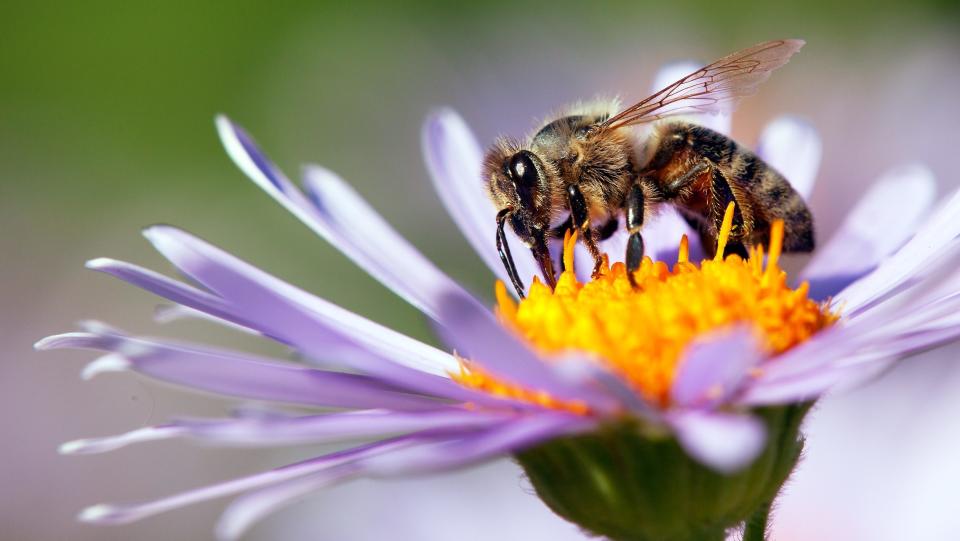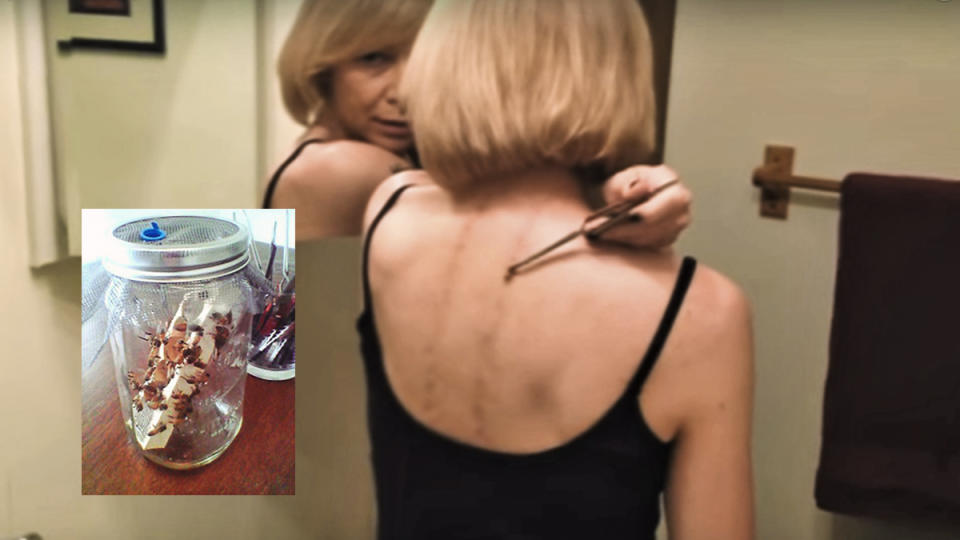"Bee Venom Therapy Helped Me Beat Lyme Disease!"
Antibiotics are the standard course of treatment for Lyme disease — a bacterial infection caused by the bacterium Borrelia burgdorferi that's transmitted to humans through the bite of infected black-legged or deer ticks. But over the last decade, an unconventional treatment has been gaining ground in the medical and scientific communities for its ability to help patients with severe late-stage Lyme disease or chronic Lyme symptoms that have not been responsive to antibiotic treatments: bee venom therapy (BVT).
It may seem wacky, but bee venom therapy works to help treat late-stage Lyme disease or chronic Lyme symptoms, says Tracy Brobyn, MD, a physician at the Chung Institute of Integrative Medicine in Moorestown, New Jersey.
She’s been using the protocol — injecting small amounts of honeybee venom just under the skin as opposed to using live stinging bees — to treat chronic Lyme disease in her patients for 10 years. She says the results are excellent when weekly venom shots are given in conjunction with the institute’s herbal protocol for Lyme. “Usually within six months, patients are better, and after a year, they’re off of everything.”
How bee venom therapy works
Bee venom therapy, also known as apitherapy, is an alternative medical practice that involves the intentional application of bee venom to the body for healing purposes. The venom is usually obtained by stimulating bees to sting a person or by safely collecting venom from bees without harming them, then injecting it into the skin with a syringe.
The reason BVT works: A compound in the venom (melittin) breaks down the protective biofilms of the Lyme-causing bacteria, making them easier to eliminate, says Dr. Brobyn. “If you only got BVT and no other meds or treatment, your body’s natural immunity could kill off some of the bacteria.”
In fact, a study in the Journal of Clinical and Cellular Immunology found that 25 percent of subjects with Lyme disease who were treated with BVT three times weekly either fully recovered or were 85 to 95 percent recovered after one year, reporting increased energy and very few symptoms. Another 75 percent of the BVT patients showed significant lessening of symptoms, while those in the control group who did not receive bee venom therapy experienced worsening of Lyme symptoms.

Case in point: Years of undiagnosed Lyme disease left Nancy Cleek Dolan with debilitating late-stage symptoms that antibiotics and other traditional treatments had failed to cure — until she discovered bee venom therapy, and it brought her back to life.
Here, Nancy shares her story, and scientists tout more amazing benefits of bee venom therapy.
Nancy's battle against late-stage Lyme
Nancy Cleek Dolan rolled over, a wave of weakness overwhelming her. "Another day I can’t get out of bed," she thought, cataloging the symptoms she had been grappling with for more than 10 years: fatigue, numbness, tingling, stiffness, headaches, light sensitivity, twitching, facial palsy, -seizures and trouble walking.
"What is happening to my body?" Nancy wondered. "Will they ever figure out what is happening to me?"
Nancy's life as she knew it changed on a camping trip to a Missouri state park in 1998 when she'd found a tick on the back of her knee. At the time, she thought nothing of it until she developed a circular, or "bull's-eye," rash often associated with Lyme disease.
(Click through for what to do if you see a tick on your skin)
Nancy visited her doctor, where the possibility that the rash might be Lyme popped into her head. But her doctor assured her, "There's no Lyme disease in Missouri." He diagnosed Nancy with a spider bite and put her on antibiotics. But when the last pill was finished, Nancy felt worse, her headaches and fatigue intensifying.
Desperate, Nancy visited 26 other doctors over the next decade and received varying diagnoses- — one doctor even going so far as to proclaim she had Lou Gehrig’s disease -— with no remedies. Relying on pain pills and growing sicker, in 2009, Nancy requested a blood test to finally rule out Lyme disease. And 11 years after her symptoms began, she tested positive for exactly what she'd feared: late-stage neurologic Lyme and multiple co-infections.
Having been granted disability, Nancy began the expensive and aggressive course of IV antibiotics and in-home critical nursing care to help her heal but to no avail. "Nothing is working," she despaired, realizing in horror. "What if this is the end?"
Nancy discovers bee venom therapy
Unable to accept that there was nothing to be done, Nancy began doing her own research. One day, a Facebook friend told her about a new treatment. "It’s called bee venom therapy, and research has shown that the venom works as an antimicrobial to detox and heal the body from resistant pathogens," Nancy explained to her doctor, who, though she’d never heard of it, said Nancy could try it and she'd monitor Nancy's progress. She also advised Nancy to take a steady dose of vitamin C to stave off anaphylaxis and have an EpiPen handy.
At first, Nancy was intimidated: BVT uses the venom from live bees to treat illness by placing stingers into the skin. Her treatment would consist of up to 10 bee stings applied every other day, three days a week, one inch to the right and left of her spine.
“What if it hurts?" Nancy wondered, when it dawned on her: "Compared to the pain I've been facing, 10 bee stings will be nothing! And if there was a chance it will help me, I have to try."

How bee venom therapy worked for Nancy
Starting out, the administration of the stingers was done by a local beekeeper, and to Nancy's amazement, her fatigue begin to lift. Then her twitches began to subside, and she found herself able to leave the house for short trips — something she hadn’t been able to do in years. After five months of treatment, Nancy was able to apply her own stings, and eight months in, she was steady on her feet again.
“When my doctor saw me walk into her office, she cried and even asked to take a picture. At that point, I was regaining feeling in my body and I was off all pain medications," Nancy recalls. "By the end of the first year, I felt I had my life back. And after two years of BVT, I’d completely recovered from late-stage Lyme and no longer needed the treatment!"
“After almost 20 years of pain and chronic illness, I’m no longer on disability," Nancy smiles. "I hope that my experience helps others who have lost hope. For me, bee venom therapy was a lifesaver — I am forever grateful!”
Doctor cautions: BVT is not for everyone
"Anyone with a bee allergy isn’t a candidate, and we always keep epinephrine in case a patient does have a reaction," says Dr. Brobyn. People who are on beta blockers also are not good candidates since the meds block the effects of epinephrine.
News! Bee venom destroys cancer cells
Australian researchers have made an astounding discovery: A major compound in honeybee venom called melittin kills breast cancer cells in the lab. “The venom was extremely potent,” says lead researcher Ciara Duffy, PhD. “We found that melittin destroys cancer cell membranes within 60 minutes.”
The scientists say it also disrupted communication between cancer cells necessary for their growth and spread,; and while it wreaked havoc on cancer cells, it had little impact on normal cells. The researchers say more study is needed to determine whether melittin can be used in cancer treatment and at what dose, but they suggest it may increase the efficacy of chemotherapy, or even reduce the amount of chemotherapy needed, saving patients from unwanted side effects. What’s more, other studies have found melittin to be toxic to melanoma, lung, ovarian and pancreatic cancers.
More great health information from First for Women:
How To Protect Against Lyme Disease
Why You Should Never Crush a Tick With Your Fingers (and Other Tick Mistakes You’re Probably Making)
For other healing journeys of real women, keep reading!
“A Drugstore Cure Calmed My Restless Legs Immediately — I Can Finally Sleep!”
“Pelvic Floor Massage Stopped My Embarrassing Bladder Leaks — For Good!”
A version of this article originally appeared in our print magazine, First For Women.
This content is not a substitute for professional medical advice or diagnosis. Always consult your physician before pursuing any treatment plan.
Solve the daily Crossword

